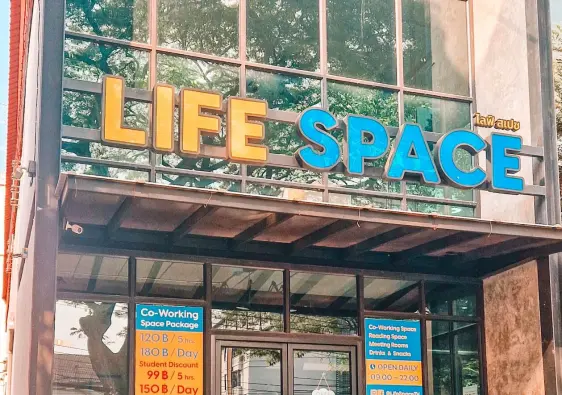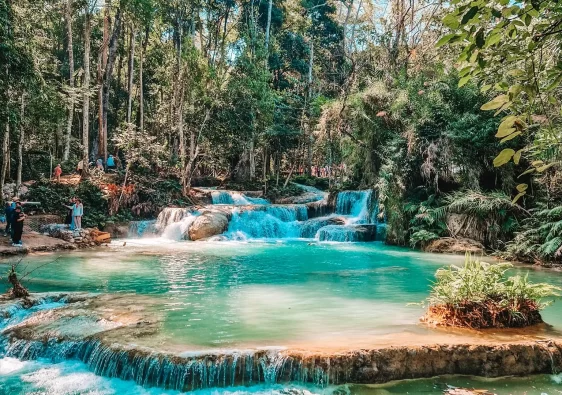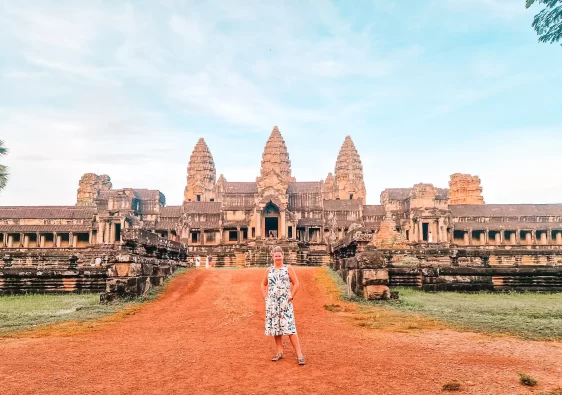Planning a trip through central Vietnam and wondering if 2 days in Hue is worth your time? Absolutely. Hue is a city where Vietnam’s layered past lives on in vivid color—where emperors once ruled from moated citadels and monks still chant in riverside pagodas. But it’s also full of surprises: from ancient tombs and the grandeur of the UNESCO-listed Imperial City to salt coffee and a graffiti-covered abandoned waterpark. This atmospheric city offers a captivating mix of imperial grandeur, cultural depth, and quirky modern charm. Whether you’re a history buff, a solo traveler, or just looking for something different, 2 days in Hue will reward you with experiences—and stories—you won’t find anywhere else in Vietnam.
Just so you know, this post contains affiliate links. If you book a tour, hotel, or buy something through one of these links, I may earn a small commission—at no extra cost to you. It helps me keep this blog running and full of travel tips. Thanks for the support!
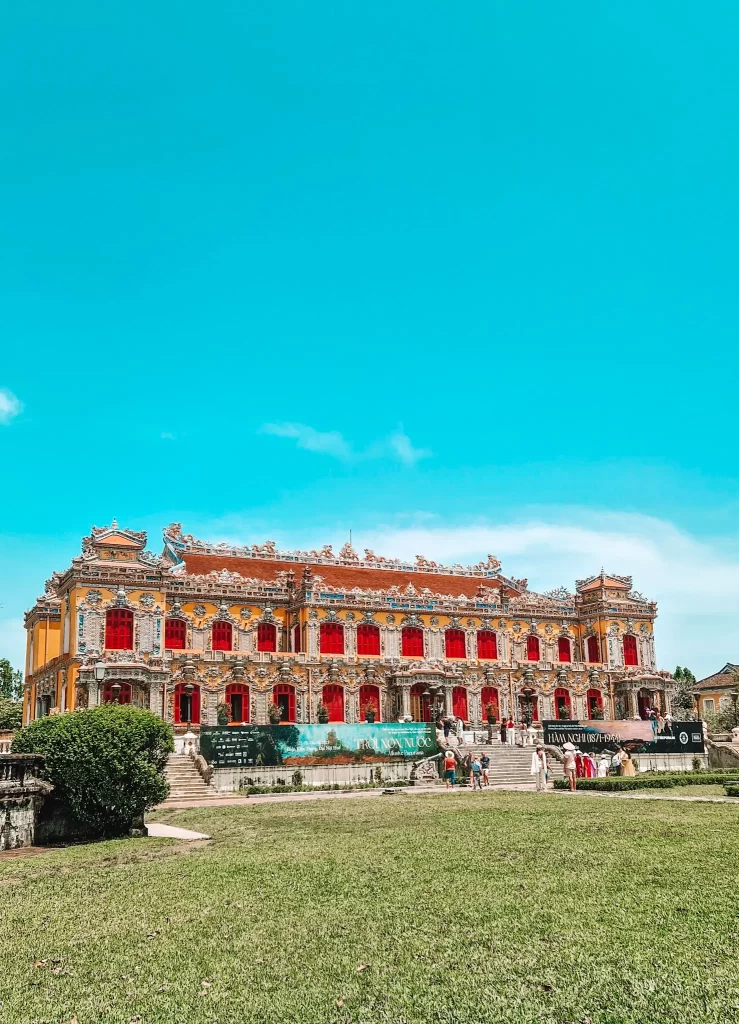
Why Hue is Worth Visiting in 2025: History, Urbex & Coffee Culture
Alongside the more famous Hoi An, this city in central Vietnam has long been a staple of Vietnam’s tourist trail due to its beautiful, historic Imperial City – I visited Hue when I came to Vietnam in 2010!
I visited the city recently in April 2025 to take a break from working on Em’s Globetrotting Gem’s in Da Nang’s excellent coworking spaces. It’s changed a lot since 2010, but the Imperial City, a UNESCO Heritage Site, remains as fascinating as ever, making it a key stop off in your central Vietnam itinerary. The famous Abandoned Waterpark, which wasn’t in any of my guidebooks back in 2010, adds another dimension to Hue now, rounding out the city with something truly unique.
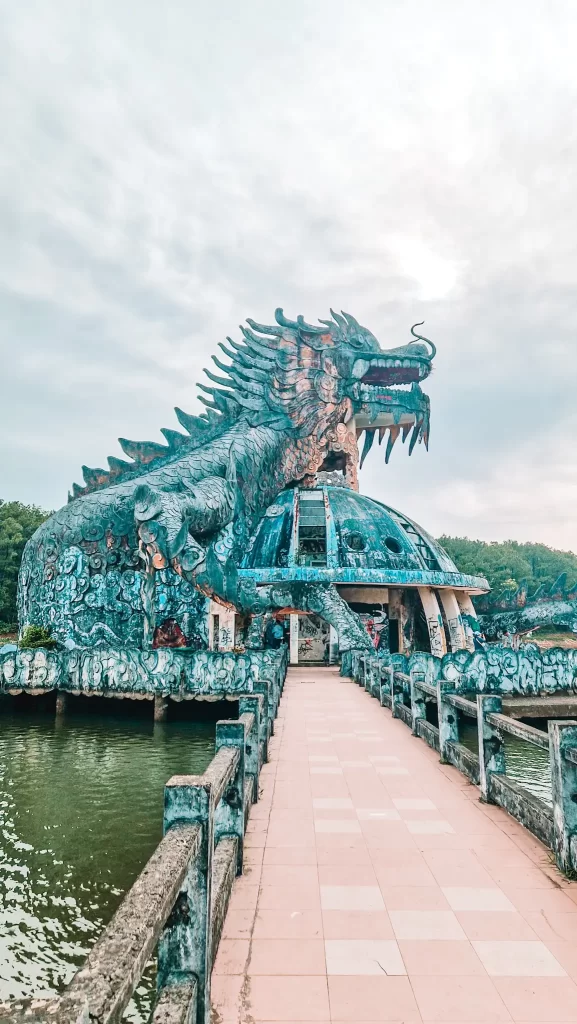
Hue also has delicious local cuisine that is very different from other dishes I’ve tried across Vietnam. This is less focused on noodles (like the Pho found in Hanoi, or the mi Quang commonly found in Da Nang), and more about delicious rice parcels!
Hue’s Imperial and Modern History
Hue, on the Perfume River, was the imperial capital of the Nguyễn Dynasty from 1802 to 1945. By the 17th century, the Nguyễn lords made Huế their base, gradually growing it into a political and cultural center.
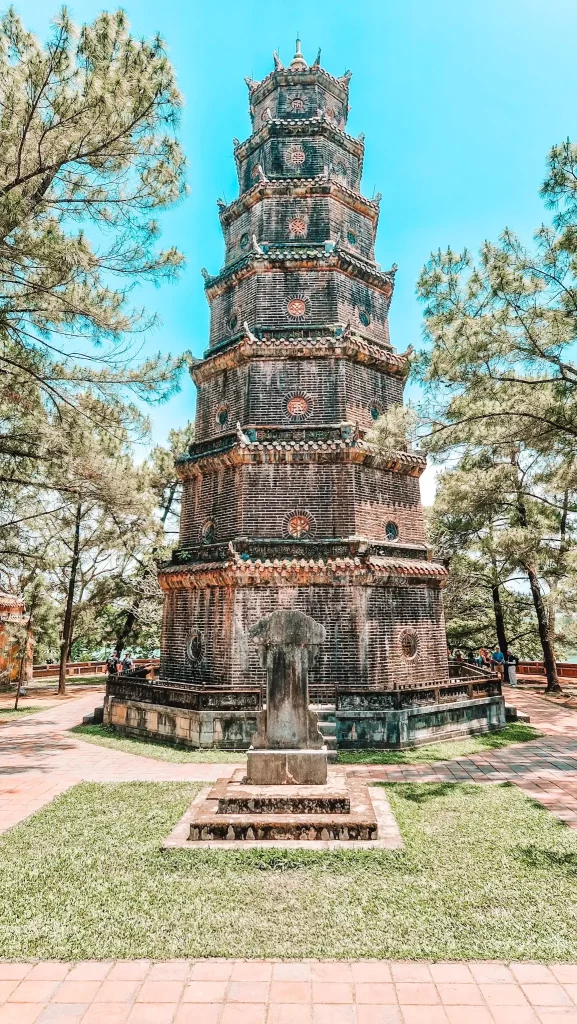
In 1802, Emperor Gia Long unified Vietnam and established Huế as the national capital. The city thrived as the heart of Vietnamese court life, Confucian scholarship, and royal traditions. The Imperial City, modeled after Beijing’s Forbidden City, became a UNESCO World Heritage Site for its historic and architectural significance.

Huế endured severe damage during the Vietnam War, particularly in the 1968 Tet Offensive, when intense fighting devastated many ancient structures and led to great civilian suffering. However, the Imperial City has been rebuilt and restored, making it once again a stunning spot to visit in central Vietnam.
If you’re interested in Vietnam’s history, consider one of these powerful novels about Vietnam (and other Southeast Asian countries) that I read before travelling.
2 days in Hue: a journey of history and urbex-ing
I’ve designed this 2 day Hue itinerary to give you one full day and one half day in Hue. This allows you to then travel on your half day – whether that’s on arrival or departure. Hue is a half-day away from other central Vietam destinations such as Da Nang or Hoi An. It also assumes you’ll spend 2 nights in Hue.
I’ve set out day 1 as your half day, as that’s how I did my trip – but if you prefer to have your full day first and then depart earlier on the second day, just flip the days around.

I’ve also suggested doing Day 2 as a day tour, as this will help you fit in as much as possible, as well as making sure you really understand the history of this part of Vietnam. However, if you prefer not to take a tour, you could space some of the things from Day 2 into Day 1, giving you two full days but a less intense itinerary.
Day 1: Exploring Hue’s famous Abandoned Waterpark
Cost: 20K VND to enter the Abandoned Waterpark (includes a water)
Stop 1: Ca Phe Muoi
Once you’ve arrived in Hue and settled into your hotel, you can see if you have time for an additional stop before you go to the Abandoned Waterpark. If you do, head out to Ca Phe Muoi, the originators of Hue’s famous Salt Coffee.
There are two Ca Phe Muoi branches – one is near the Imperial City, but the original is in a more residential area of Hue. I chose to take a Grab bike to the original, but it’s also about a 20 minute walk from the main hotel area.
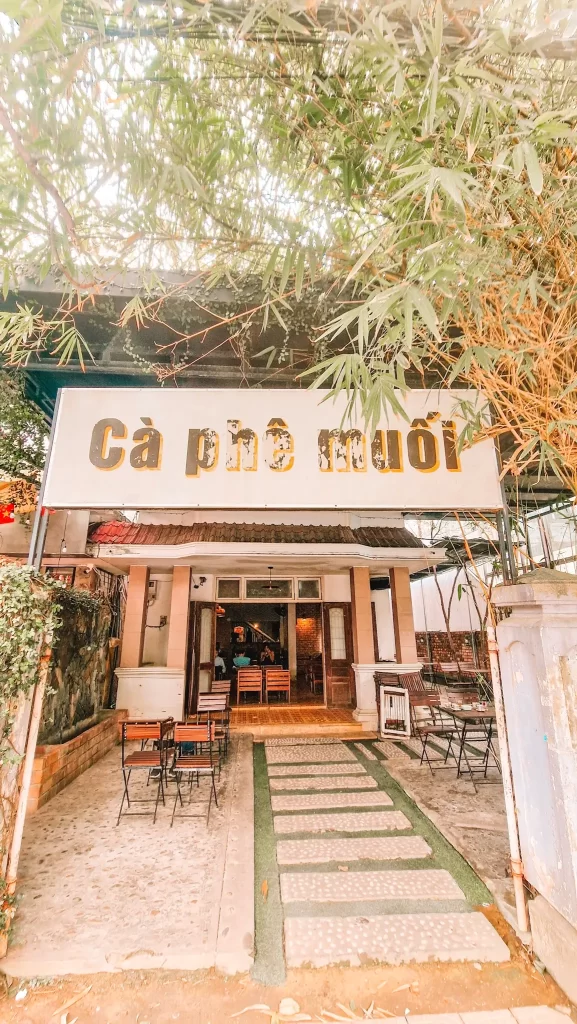
The honest review is that the cafe is completely unassuming. It’s a real neighbourhood place, and I was the only Westerner when I visited – I really did feel like a local. But it’s a cafe that changed the coffee world forever back in 2012, when the owners created the delicious Ca Phe Muoi, or Salt Coffee. I’ve drunk so much Cafe Muoi in Da Nang’s beautiful cafes that I was glad to pay my respects – and visit somewhere so off the beaten track!
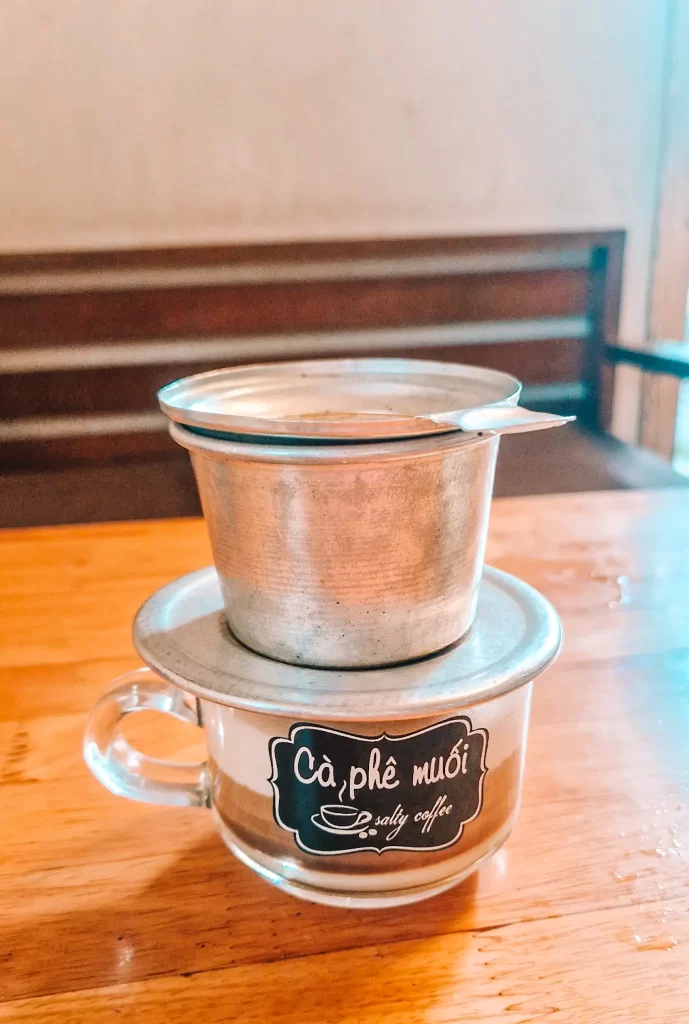
Even if you don’t have time to make it to Ca Phe Muoi, make sure you try some of the delicious salt coffee available everywhere in Hue. You won’t regret it. And if you don’t drink coffee, consider asking for it with cacao, as a friend of mine did recently.
Stop 2: Explore Hue’s Abandoned Waterpark – Urbex with a View
Cost: 20K VND entrance fee
Once you’re full of caffeine, set off for Hue’s famous Abadoned Waterpark. Easily found on Google Maps, this site is on the outskirts of the city. Officially known as Ho Thuy Tien Water Park, it was originally built with big plans in the early noughties. It cost around $3m USD to build, was intended to capitalise on Hue’s existing tourism popularity due to the Imperial City.
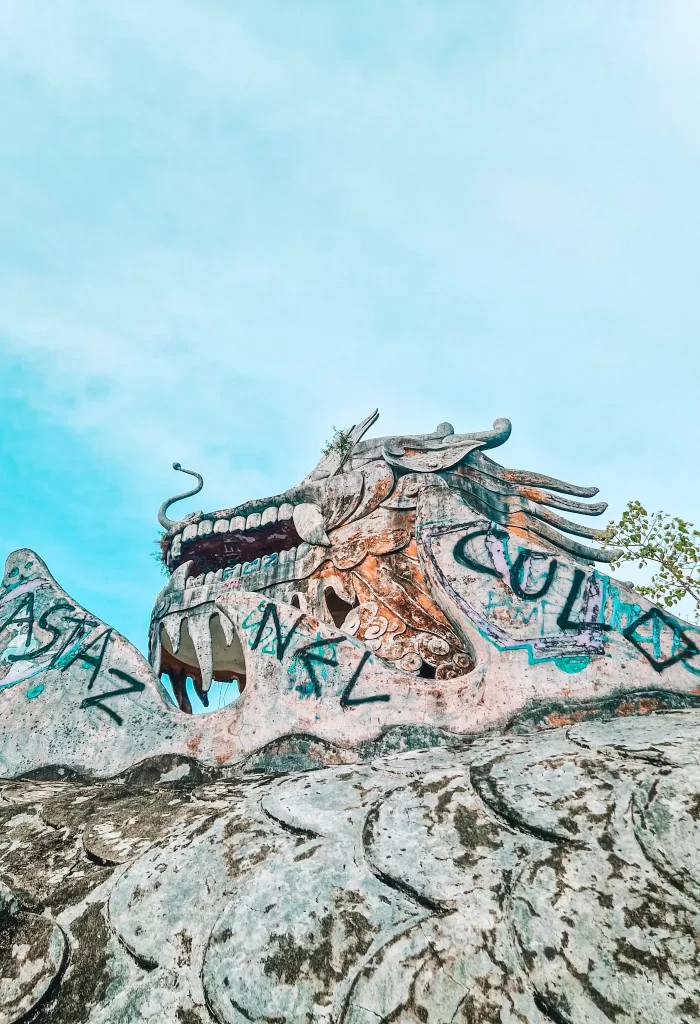
However, it wasn’t a success. Within a few years, it closed down and has been shut ever since. An effort in the noughties to revitalise it by another company came to nothing, and it now sits, covered in graffiti, in Hue’s countryside.

It’s a truly eerie experience. The main attraction is the huge Dragon guarding a domed building, which is now completely covered in graffiti. Poke around inside and you’ll find the stairs up to the dragon’s mouth, where you can pose between the teeth. The inside is much as you’d expect an abandoned building to be – dark, damp and eerie, but it’s still possible to see hints of what it’s purpose might have been.

Once you’ve had your fill of the dragon, follow the path around the beautiful lake. You’ll soon come to the waterpark part of the complex, where you can explore abandoned slides and see what would once have been a happy swimming pool for families. I loved this even more than the dragon – it has a real ‘The Last of Us’-vibe and as a lover of dystopian fiction, I was in heaven.

Continuing on, I found one last hidden abandoned attraction – an old simulator! These were so common when I was a teenager, but they’ve disappeared now and I’d forgotten they existed. If you’re strong enough, you can even prise open the door to see the seats inside (a kind person was doing this when I arrived so I got to peek in).
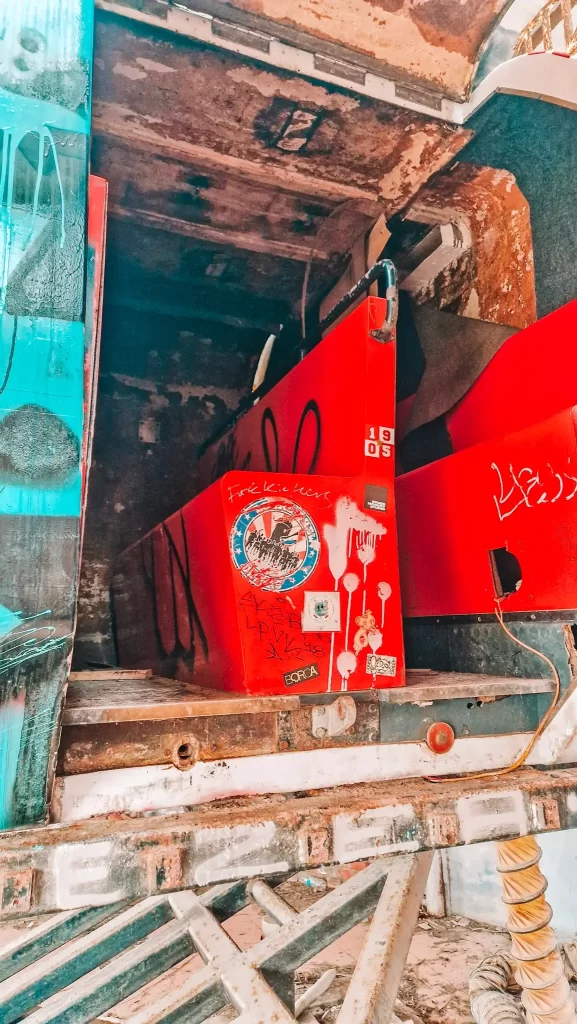
Visiting the Abandoned Waterpark is one of the most unique things I’ve experienced in nearly ten months in Southeast Asia. It’s a great way to do some urbexing without danger, as it’s an entirely safe experience. And the scenery is stunning – as I walked around the final bit of the lake, I took one of my favourite photos of all time.
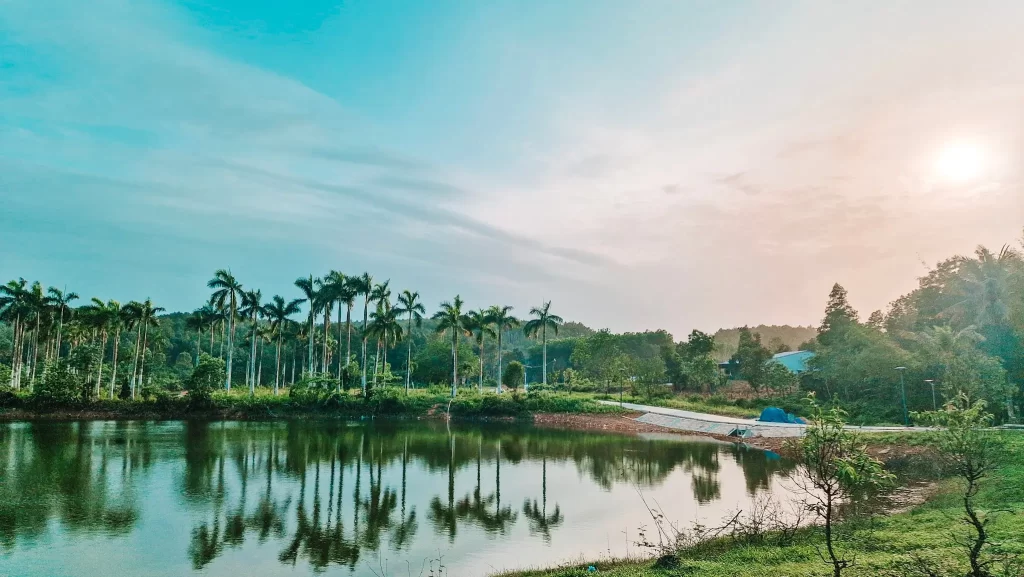
Practicalities
While it was certainly abandoned when I visited in 2010, it wasn’t on the tourist radar. However, it’s now a reasonably popular tourist attraction in Hue. When you arrive, locals will ask you for a small entrance fee, and there is a stall to buy drinks. The path around the lake is newly paved, making it an easy experience even for people with relatively limited mobilty – however, there are still a couple of bits of rough ground, so it’s not yet suitable for wheelchair users.
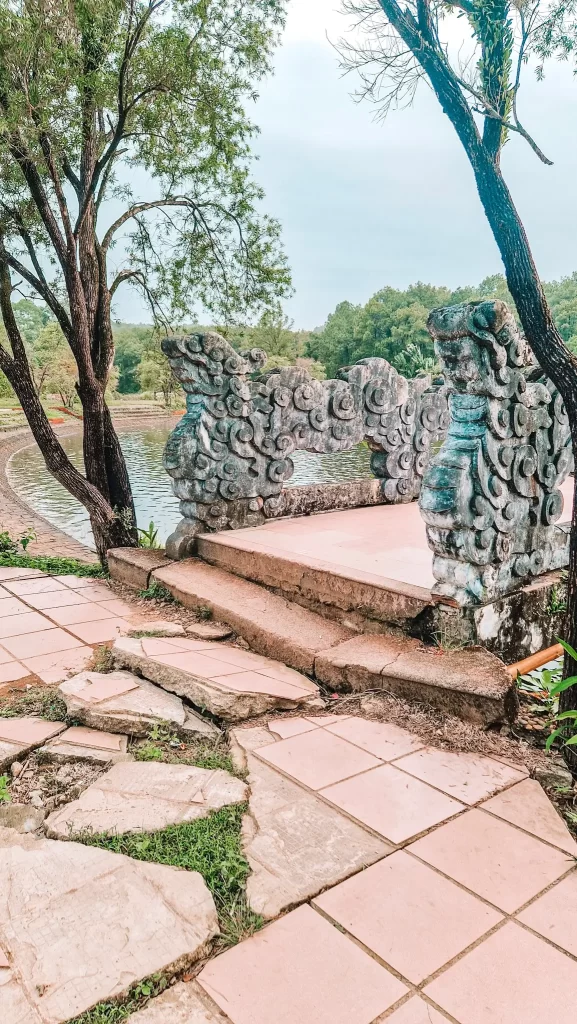
How to get to the waterpark
- Take a Grab car or bike: The Waterpark is about 20 minutes away from the main tourist area of the city by Grab Bike, which is a great option for solo travellers. I was worried about not being able to get a Grab back, but this has become such a popular attraction that there were Grab drivers hanging around waiting at the entrance.
- Rent a motorbike: The Abandoned Waterpark is an easy drive from Hue, making it an easy stop if you’re renting a motorbike. While I didn’t use them to rent a motorbike, I used Motorvina for my Easyrider trip on the Hai Van Pass and it was clear that they were a popular, reputable company that took their job seriously.
After returning from the waterpark, explore Hue’s lively tourist streets and the scenic Perfume River. You’ll find a host of restaurants and bars, particularly on Hue’s Walking Street, as well as a few lovely tourist boutiques for more thoughtful souvenirs.
Day 2: The Imperial City, Tombs and more
Cost:
- 400K VND for a day tour (approximately, if you buy this locally you may be able to barter)
- 420K VND for Imperial Citadel and tombs combo ticket
- 50K VND for Garden House entry
For day 2, I recommend taking a guided tour. I visited Hue’s Imperial City without a tour guide in 2010, and I don’t recommend it. While some places I’ve explored in Southeast Asia are great to do independently, when it comes to historic sites, I always find a guide brings a lot to the experience. Without historical context, the locations soon become a blur of similar-looking old buildings. In addition, if you’re on a tight schedule, tours usually let you see more because they’re efficiently run. They’re also great for solo travellers – I even made some friends I later joined for drinks and dinner.
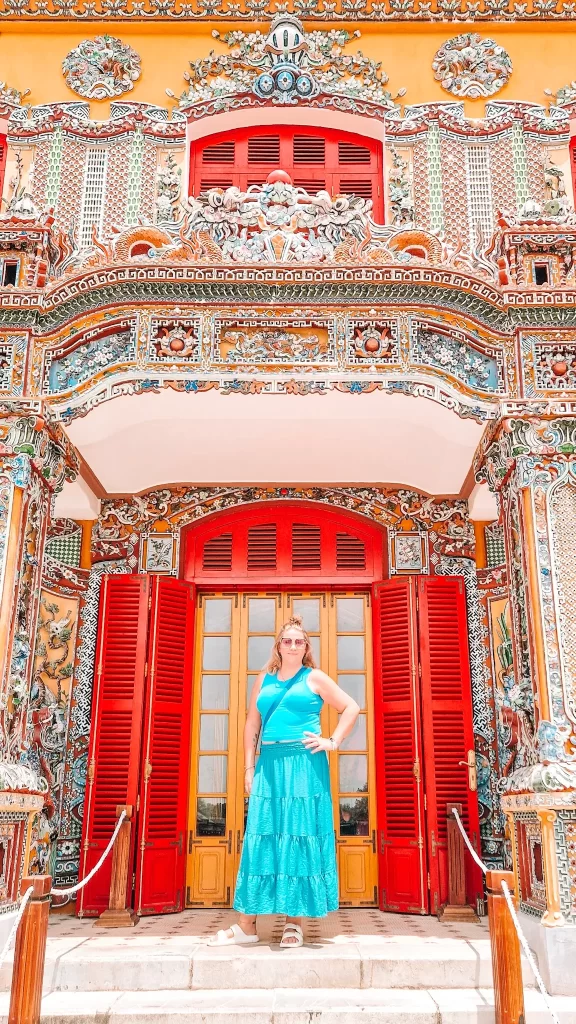
I used a group tour from Get Your Guide. It’s highly rated and included lunch, and we were a group of about 30. The guide was well-informed and kept us on track really well – and it was a packed day.
If you choose to go independently, I recommend trying to find a guide at least for the Imperial Citadel to fully understand the important role the site plays in Vietnamese history. You can often hire a licensed guide just outside the Imperial City entrance—expect to pay around 200K-300K VND for a private walkthrough.
Stop 1: Imperial Citadel and City
This is your longest visit of the day, and that’s for the best as the heat can get intense later in the day! The Imperial Citadel became the administrative centre of Vietnam following the unification of the country in 1802, and remained an important part of government until the end of the Nguyen dynasty in 1945.
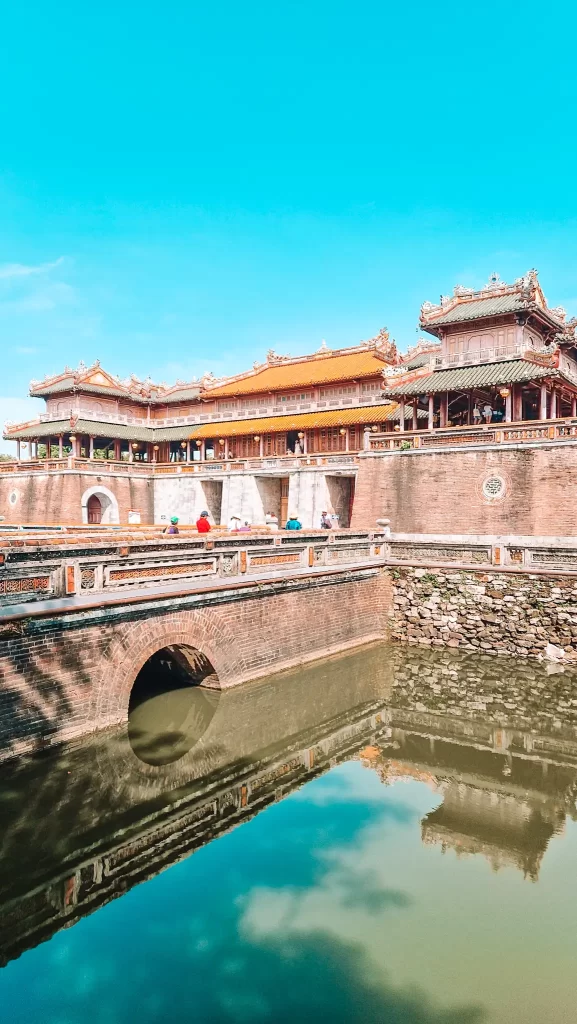
The tour covers various parts of the citadel and city, helping you understand the reigns of different Vietnamese emperors along the way.One of my favourite sites was a room with pictures of the Nguyen Emperors, so you can see how styles changed over time.
You’ll finish up at the incredible Kien Trung Palace, built in the 1920s by the penultimate Emperor in a French-inspired style. It’s a gorgeous building that symbolises the affinity the last Emperors felt for their French colonisers, one of the reasons they became so unpopular.
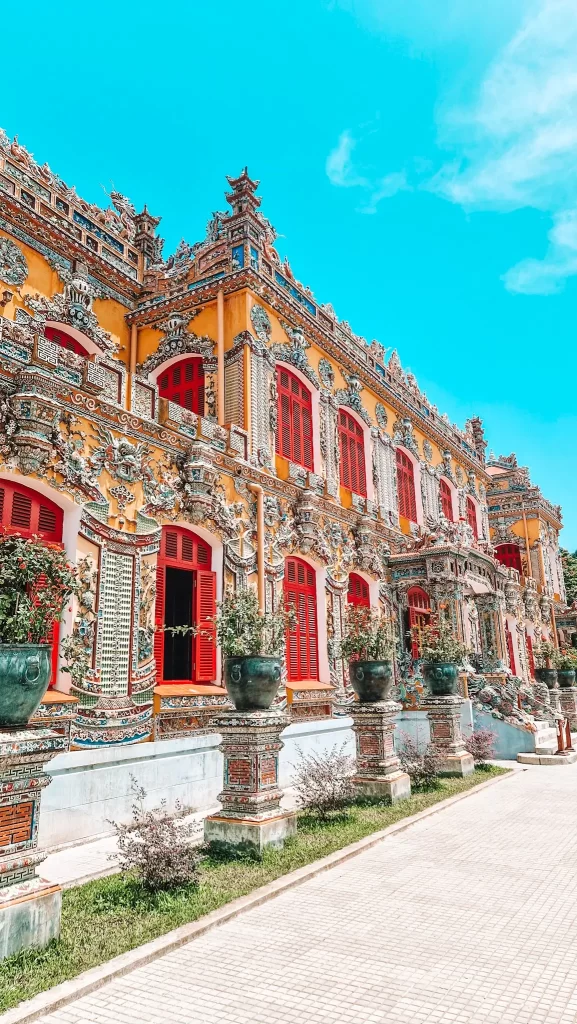
As you walk through the Imperial City you’ll also see the ongoing restoration work to rebuild parts of the city – as a huge archeology fan I loved this!
You’ll be at the Imperial Citadel for about three hours. While there are a few opportunities to buy water, I would suggest bringing a decent-sized bottle as if it’s hot, you’ll need to stay hydrated.
Stop 2: Ancient Hue Garden House
After three hours wandering the beautiful Imperial Citadel, everyone was more than ready for a coffee. Our guide took us to the Garden House, one of the ‘ancient houses’ so typical in Vietnam. It’s an old family home that has been kept as it would have been around 100 years ago, and the family has opened it up as a tourist attraction.
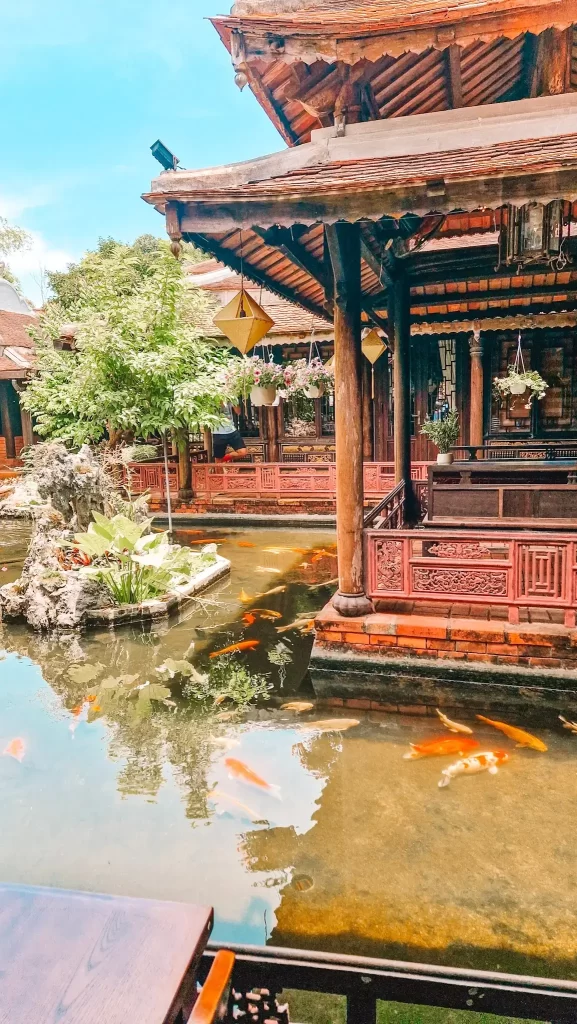
It’s known as the Garden House because of the beautiful garden setting. You’ll be pleased to know that this includes a cafe – there was definitely a rush for coffee from my tour group. There’s also a beautiful koi pond and a sense of serenity, and this was a much-needed break after the more intense sightseeing.
However, if you are visiting Hue independently, this is definitely more of a coffee and rest stop than a must-do historic sight, and could be skipped.
Stop 3: Thien Mu Pagoda, or the Pagoda of the Celestial Lady
This beautiful pagoda is your last stop before lunch. Set on the banks of the Perfume River, the impressive seven-storey Thien Mu Pagoda was built in 1601. It’s a major part of Hue’s history, including local folk history.
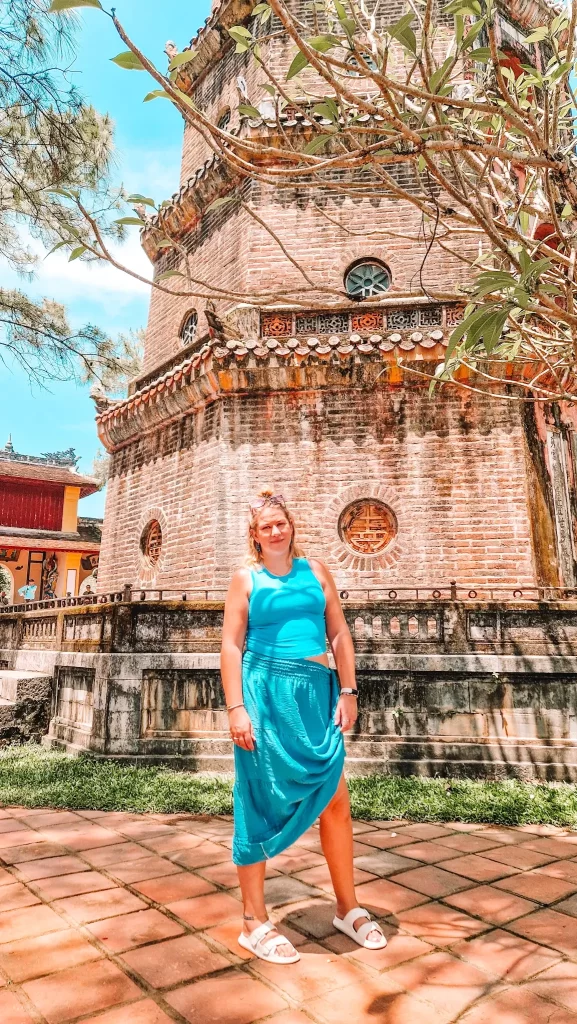
The Pagoda is a beautiful spot and makes for great photo opportunities. I was also in love with the realistic hair on some of the statues – I’ve never seen this before.
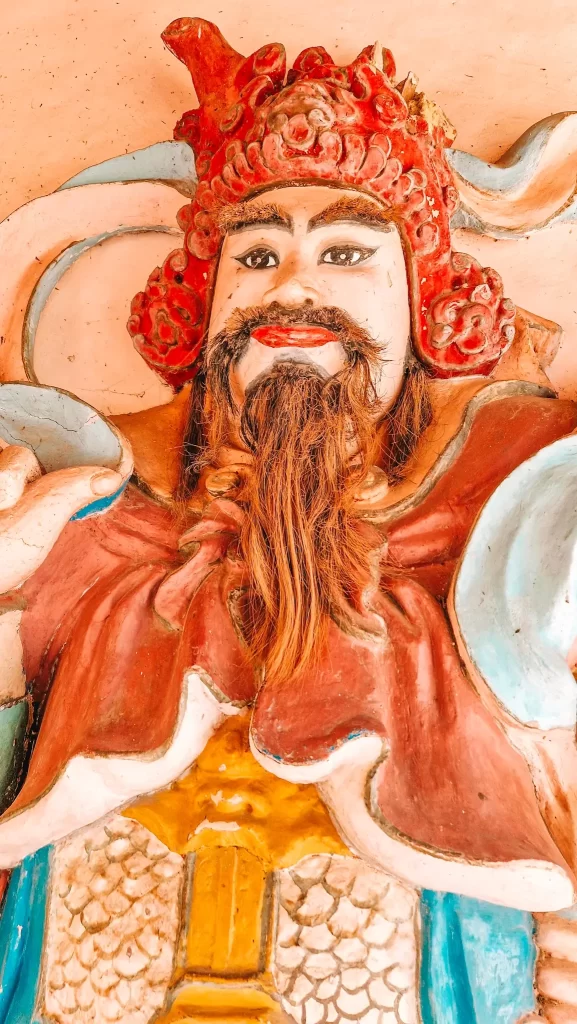
Stop 4: A delicious lunch on the Perfume River
After you’ve experienced the peace of the Pagoda of the Celestial Lady, you’ll head down to the Perfume River for lunch on board a traditional Dragon Boat. You’ll float gently along the river as you try classic Vietnamese dishes.
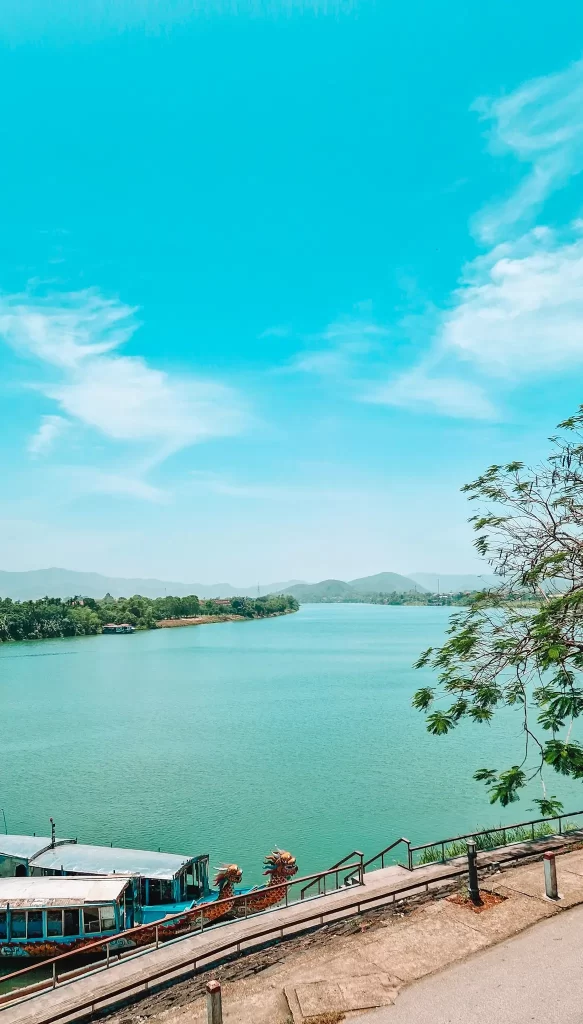
For our tour, vegetarian options were also available, athough somewhat limited.
Stop 5: Discover Hue’s Colorful Incense Village
After lunch, we headed to Hue’s famous Incense Village to learn about one of the city’s main industries. Hue is historically famous for incense production, and this village dates back about 700 years, with incense production responsible for the naming of Hue’s Perfume River.
You’ll get the opportunity to see how incense sticks are made and even get to try making incense yourself! We got to hold the sticky incense before it was put onto the sticks – it was a bit reminiscent of warm plasticine, and a very unusual texture.
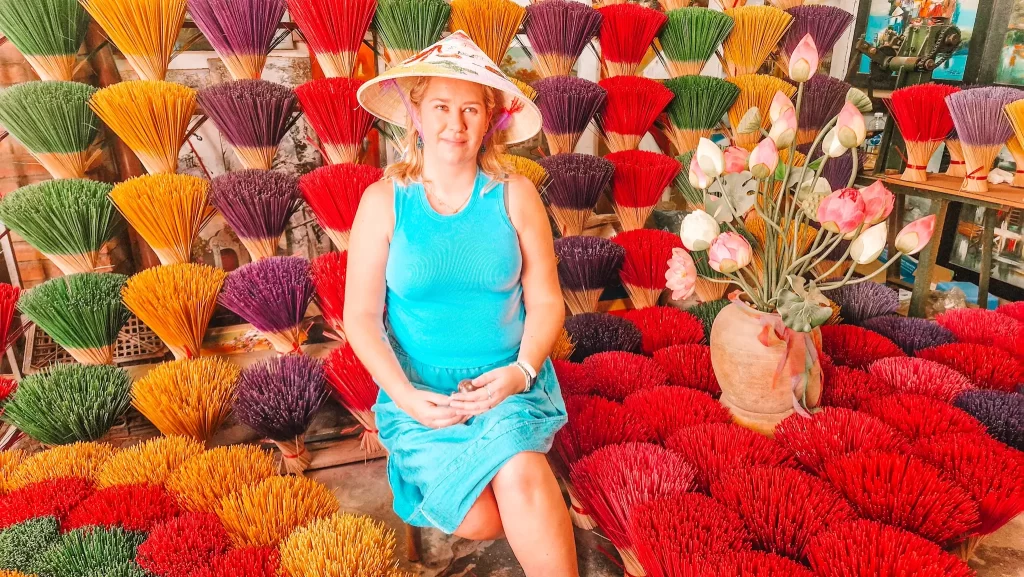
The village has also been turned into an Instagram paradise. All the shops have photo areas set up to get incredible shots of the different colours of incense.
If you are doing this tour independently, this isn’t an essential stop, but it is a nice one. You’ll get a chance to support local artisans who, without tourism income, may have gone out of business long ago.
Stop 6: Tomb of the Emperor Tu Duc
Next, we went to our first tomb, of the Emperor Tu Duc. He was the longest reigning monarch, from 1848 to 1883 and had a staggering 104 wives. Despite his many wives, he had no children and adopted his nephew—perhaps explaining the presence of phallic symbols at the site.
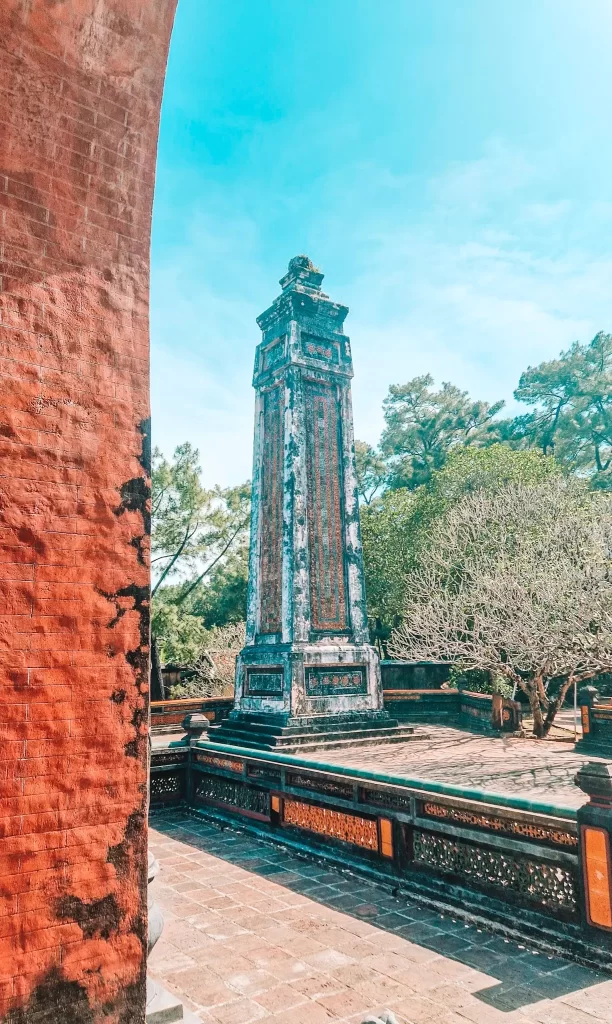
As was traditional, Tu Duc began planning his tomb long before his death, in the 1860s. He was afraid of his body being stolen, so the tomb is (comparatively) restrained, as his body is interred elsewhere. However, the tomb was still seen as opulent by the population, and there was a failed coup in 1886 as a result of the taxation needed to pay for them.
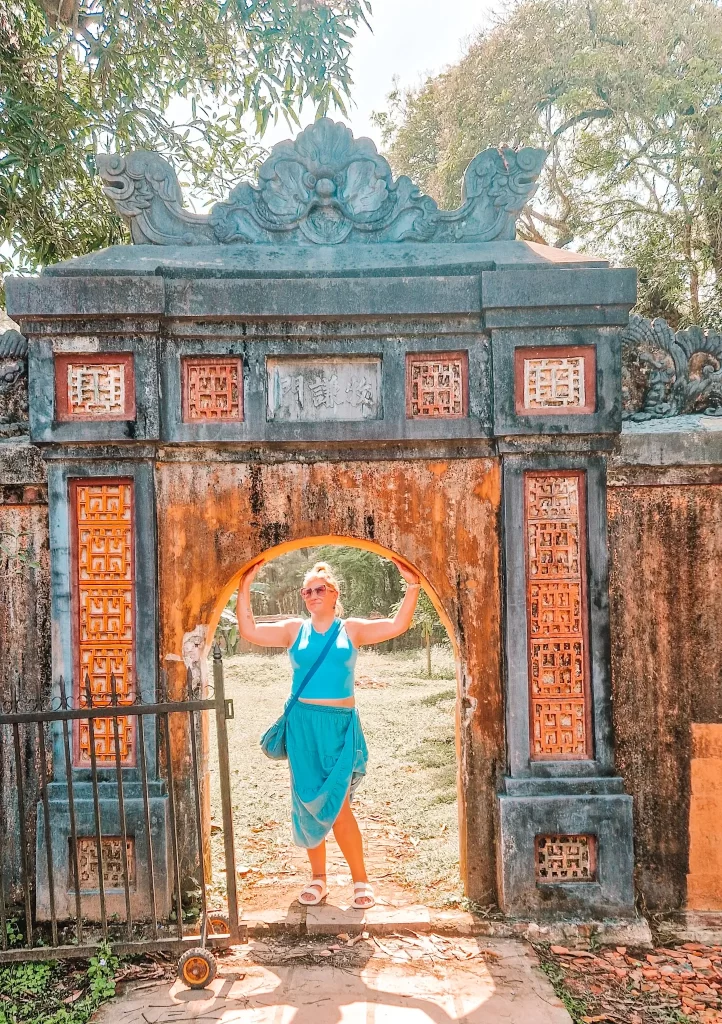
While the tomb was intended as a monument to Tu Duc after his death, he also lived there with his family during his lifetime, and the tomb therefore reflects his personal interests including a fishing lake.
According to Wikipedia, the 200 labourers who buried his body in it’s secret location were then beheaded. Even if this is rumour, the actual tomb remains undiscovered to this day.
Stop 7: The beautiful Vong Canh Hill
After the ornate grandeur of Emperor Tu Duc’s tomb, it was nice to get back to nature at the lovely Vong Canh Hill. Popular with locals of all ages, from young couples to families lounging with chilled drinks and picnics, this hill offers a stunning view of the Perfume River.
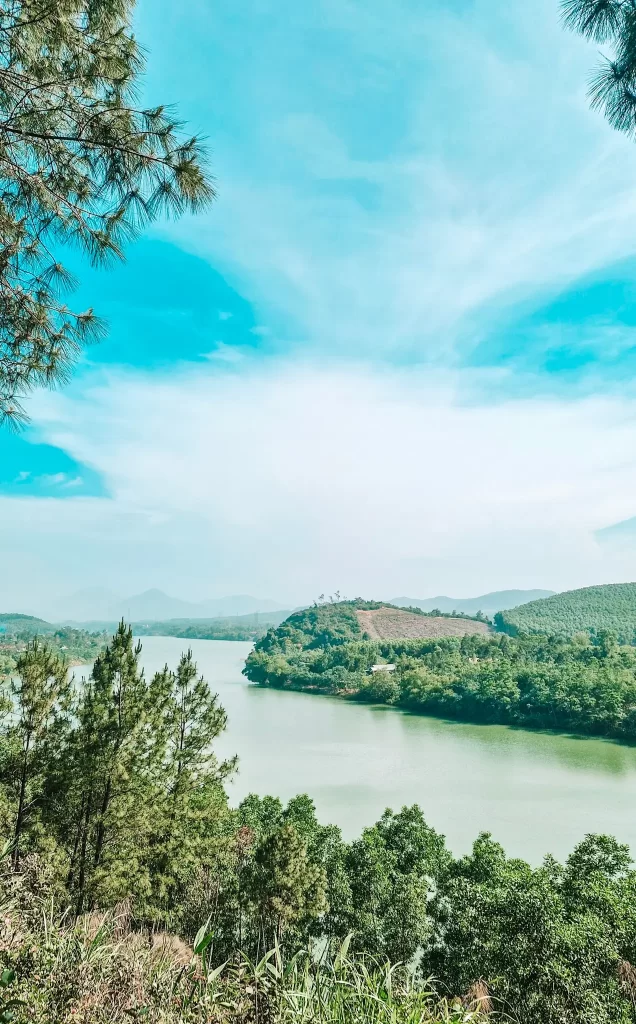
This quick stop is another chance for a brief rest, as you reflect on what has already been a busy day full of Hue’s intriguing history. There are vendors selling drinks to make sure you stay hydrated, and even a free water-refill point with filtered water.
Stop 8: Your final stop at the tomb of Emperor Khai Dinh
It was only when we arrived at the Tomb of Emperor Khai Dinh, our final stop, that we realised just how restrained the tomb of Tu Duc really was. This massive monument was built for the penultimate emperor in the early 20th century. He was widely seen as a puppet of the French, and the tomb reflects this, designed in a mix of French and Vietnamese styles.
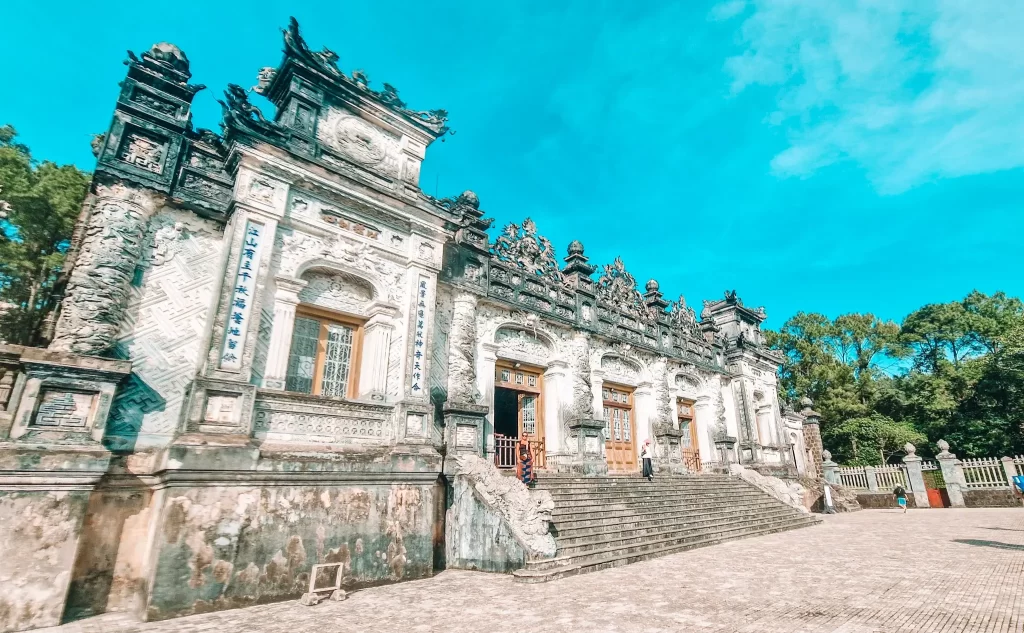
When you arrive, you’ll get a chance to pose on the imposing staircase before climbing to the different levels of the mausoleum. The indoor tomb itself is enormously opulent, with red and gold detailing and a photo of the monarch.
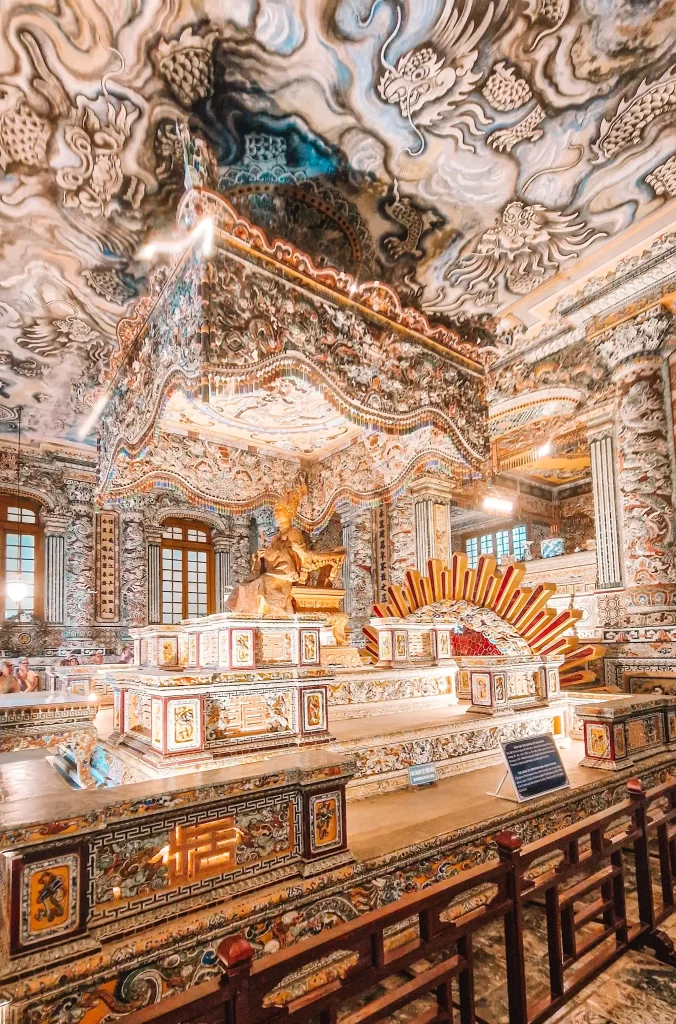
The tomb is set atop a hill, offering sweeping views of the surrounding countryside. It’s the perfect place to reflect on the extravagant legacy of Vietnam’s final emperors—and how their lavish lifestyles may have contributed to their eventual fall from power.
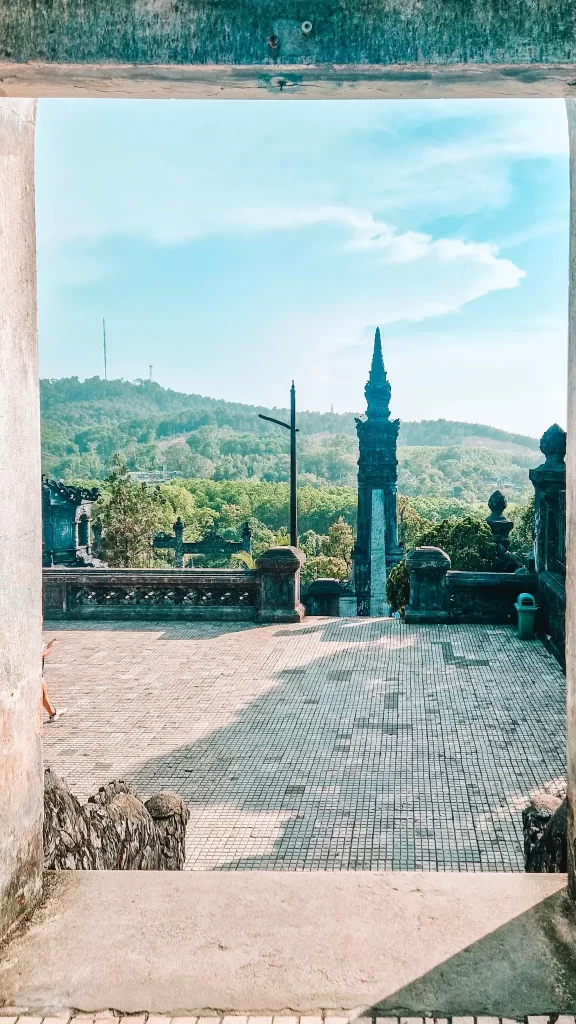
Note that there are lots of stairs at this tomb. While we took them slowly, it means that the site isn’t very accessible if you have limited mobility.
This finishes up your day of sightseeing across Hue’s many beautiful monuments. While it’s an intense day, I felt like I made the most of every hour and came away with a deep appreciation for Hue.
Dinner options in Hue
After such busy days in Hue, you’ll be more than ready to sample some of Hue’s unique local cuisine, and there is great vegan food in Hue! While I’m not a vegetarian, I don’t eat meat often, so I found a couple of great vegan restaurants in Hue that I highly recommend:
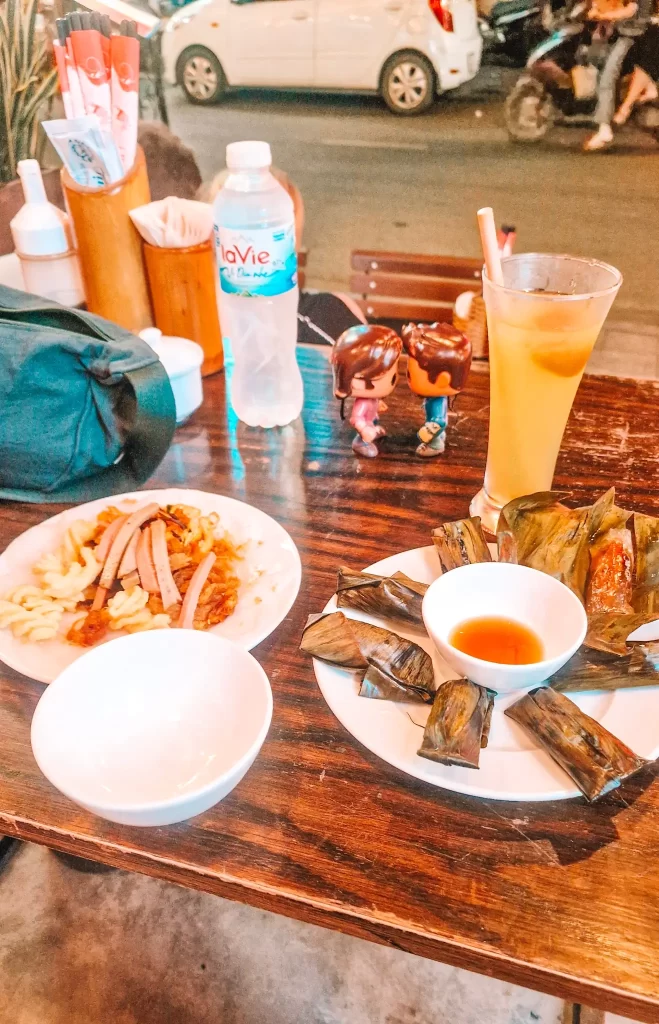
- Tinh Tam Vegan – right in the heart of Hue’s tourist streets, Tinh Tam Vegan offers the opportunity to try Hue’s specialties, but with a vegan twist! I tried:
- Nam Rice Cake: a steamed rice cake traditionally made with rice and fish sauce
- Loc Rice Cake: made with tapioca and traditionally shrimp or pork
- Beo Rice cake:a strange option that felt like crisps (or chips, For us readers) traditionally served with shrimp
- Fried vegetable spring rolls
At Tinh Tam, all the rice cakes were mushroom and tofu, rather than the traditional meat or fish. I loved the food and the service so much I went back twice.
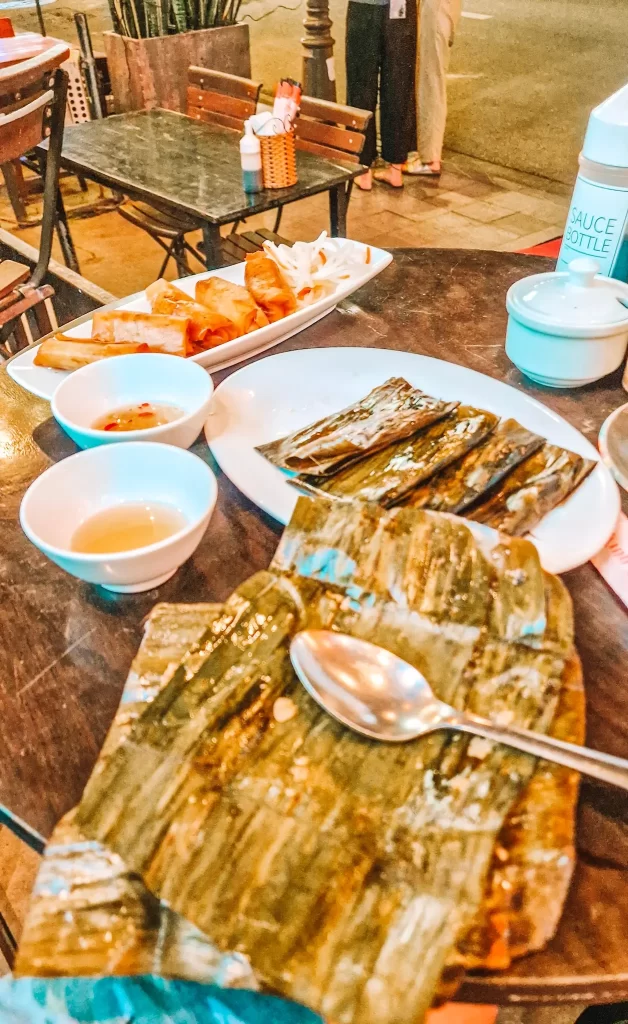
- Mingle Vegetarian Cafe – down a quiet alley off a busy side street, Mingle is set in a green courtyard. It has a more varied menu, offering veggie and vegan versions of Asian and Western classics, including brunch and breakfast food. I had their Pad Thai and they showed great awareness of vegan diets by checking I was ok with egg. I also had their breakfast waffles – delicious! Mingle the opportunity to eat great vegan food in Hue, all in a leafy green setting.
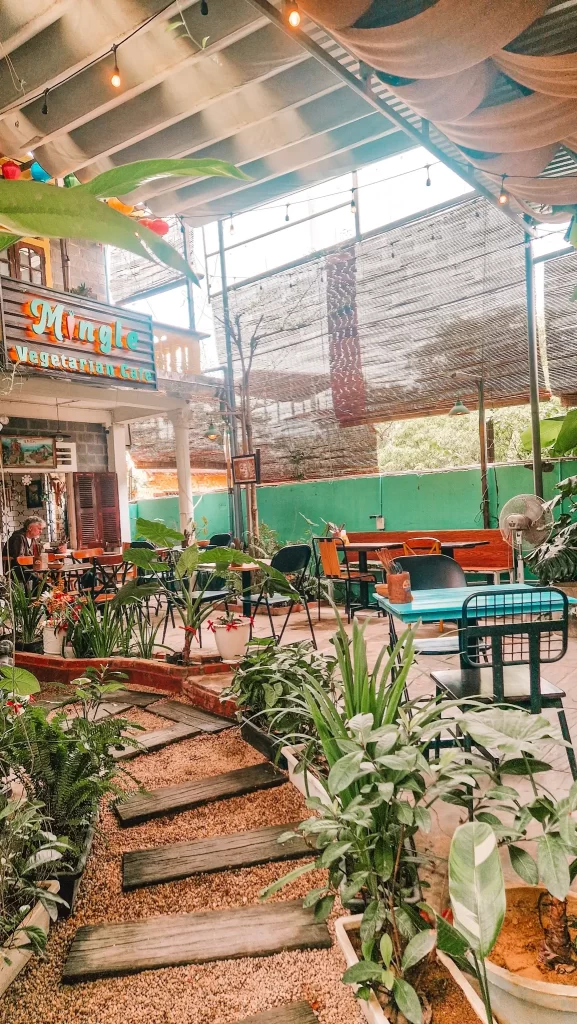
FAQs
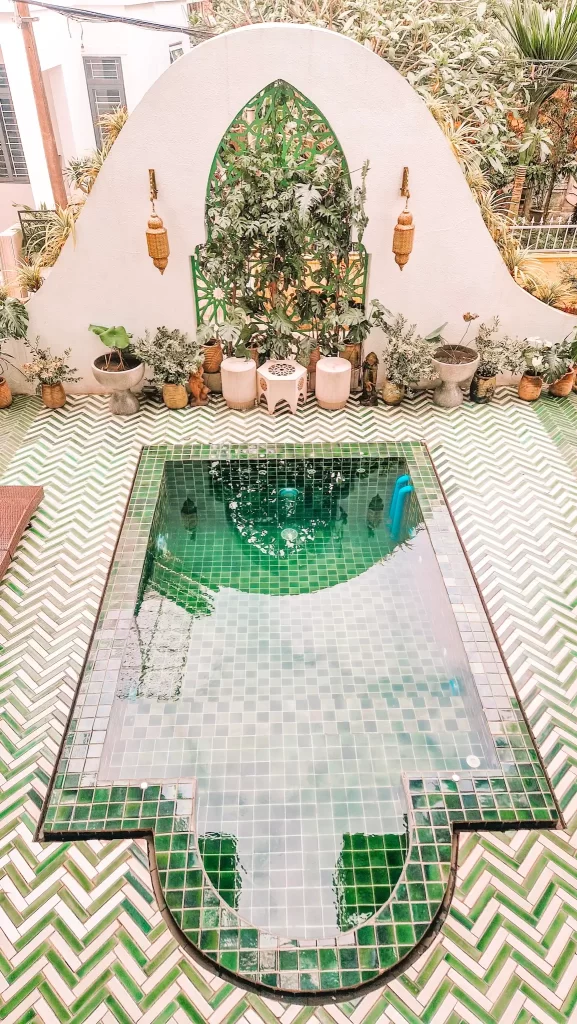
Where is Hue
Located in central Vietnam, Hue sits along the Perfume River. It’s north of the gorgeous UNESCO city of Hoi An, far south of bustling Hanoi and well north of busy Ho Chi Minh City. The nearest major city is Da Nang, a growing digital nomad hub with few traditional tourism draws but lots of unique experiences.
When is the best time to visit Hue?
Vietnam has a seasonal climate, and differs in the south, north and central regions. For Hue, the best time to visit is spring, between February and April. During this time you’ll get moderately warm weather (around 20°C–25°C), and limited rain.
In summer, from May-August, central Vietnam gets prohibitively hot and humid, with temperatures up to 38°c. While you can visit during this time, long sightseeing days such as the Imperial City would be very difficult.
From September to December is the rainy season, which also makes tourism difficult. However, it will be cooler during this time. This is also typhoon season in central Vietnam so extreme weather is possible. January is considered a transition season between the wet season and the better weather in spring.
Is Hue Safe
Vietnam is generally a safe country for tourists, and Hue is no exception. The British Foreign, Commonwealth and Development Office notes that violent crime against tourists is rare, but that some incidents of typical tourist crime such as pickpocketing and bag snatching do occur. As always, especially if you’re traveling alone, stay aware of your surroundings and take common-sense precautions.
They also note that there is a possibilty of sexual assault and drink spiking, as there is in most cities. If you’re a female traveller, take the usual precautions of using licensed taxis, including Grab. Try not to walk around alone late at night and buy your own drinks.
However, while you should always be aware of your belongings and surroundings, Numbeo reports very low levels of crime in Hue, and I felt very safe while I was there.
How many days should you spend in Hue?
Two days is a good amount of time to spend in Hue as part of your central Vietnam itinerary, allowing you to see the main sights. While you could see much of Hue’s historical sights in one day, it would be difficult to also see the Abandoned Waterpark in just one day. If you have more time in Hue, you could space out your visits to Hue’s many historic sights, and spend more time relaxing, particularly if your hotel has a pool.
Where should I stay in Hue
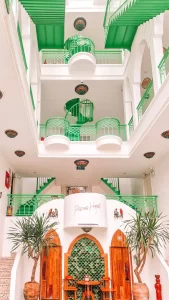
The best area to stay in Hue is around the central tourist streets, although I would avoid staying directly on busy streets such as Walking Street due to the noise from local bars. Several hotels are down quiet, safe backstreets and these are a great combination of proximity to the centre combined with peace.
Pisces Hotel – this incredible hotel is where I stayed. The design in just amazing, making it one of the most Instagrammable hotels I’ve ever stayed in. While I sadly found that the water pressure wasn’t quiet strong enough for the enormous bathtub in my room, I would still recommend this hotel for its central location and spacious rooms. Instagrammable without feeling overhyped—Pisces is the kind of place you’ll want to come back to
Than Thien Friendly Hotel – this is where I’d booked to stay before I found the Pisces Hotel. It’s a highly rated, budget hotel in a central location. I did however note that it’s on a street with a lot of traffic, so if you’re a light sleeper consider asking for a room at the back.
How to get to Hue: Air
Hue’s Phu Bai International Airport is located just south of the city, about 30 minutes drive from the city centre. While I haven’t visited the airport to confirm, it’s likely that Grab is easily available from the airport to the city, as well as regular taxis. However, there are some reports that Grab is prohibited from picking people up at the airport itself, so you might have to walk a bit to find your Grab driver. It’s unclear whether these reports are fully up to date, as my Grab App shows that I can request a car from the Arrivals area.
My Grab app shows a current cost of around 250K VND for a trip from the airport to central Hue.
How to get to Hue: Train
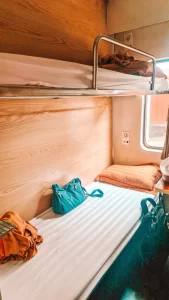
travel in Vietnam is a great way to get around. Hue is on the main Reunification Express trainline from Hanoi to Ho Chi Minh City. The nearest major stop is Da Nang, and many people will make the journey between Da Nang or Hoi An and Hue by train. You can also get the train from Hanoi to Da Nang easily (about 14 hours) or from Ninh Binh. Find schedules here.
This is what I did, and it was an easy, if slow, journey. The views along the journey are spectacular, taking you along the Hai Van Pass.
I booked via 12goasia, who then purchase tickets on your behalf – note that this means there won’t be instant confirmation, and tickets aren’t guaranteed.
The journey takes about three hours, so I choose to do it as a morning trip on my first day, arriving at about 2pm. There were three travel classes available, and the price differential between classes was about £1:
First Class Sleeper – a sleeper bed in a 4 berth carriage, with a pillow and blanket (my choice).
Second Class Sleeper – a sleeper bed in a 6-berth carriage (3 per side). I saw these as I boarded and was glad I hadn’t chosen one, as they looked very cramped.
Second Class Seat – an upright seat in an airconditioned carriage.
To my surprise (and joy) there were Western-style toilets available (at least in First Class). These were also reasonably clean and had toilet roll.
These carriages are operated by Vietnam’s national rail company, unlike the more polished private operators on nighttime routes. My bed wasn’t clean when I got on, and there were no snacks offered (although a food cart did pass by, and lots of people actually got off briefly at Da Nang for snacks). However, it’s absolutely fine for a couple of hours.
If you’re planning a longer train journey in Vietnam, I really recommend it! Check out my full guide to Vietnam’s sleeper trains before you plan your trip.
How to get to Hue: Bus
Like much of Vietnam, Hue is well-linked by an extensive bus network. Buses run to Hue from destinations such as Hanoi (about 13 hours), Da Nang (about 2.5 hours), Hoi An (about 3 hours), Ninh Binh (about 12 hours), Nha Trang (12-15 hours), Sapa (17-19 hours) and even Ho Chi Minh City (about 20-24 hours).
Buses in Vietnam vary in quality and comfort. If you are taking one of the longer journeys, research your bus to make sure that you are getting the comfort level you want for your budget. For example, VIP Sleeper buses offer two beds per row and are spacious and comfortable, while ordinary sleeper buses have three beds per row and, therefore, much less space.
If you’re going a shorter distance, you will most likely be in a minivan, but the number of seats will make a real difference to comfort and quality levels.
Finally, there are frequent rumours about the lack of safety on Vietnam’s buses, with drivers speeding on the roads. I would personally avoid picking the bus with the shortest journey time on a long-distance bus, as this is likely to lead to added pressure on the driver to go fast.
How to get from Hoi An to Hue
Getting from Hoi An to Hue is easy and relatively quick! You have three choices:
Take a direct bus or van (approximately 3 hours)
Take a van or Grab to Da Nang and catch the train to Hue. (approximately 40 minutes to Da Nang, and then 3 hours on the train.)
Road – you can get a private car, rent a motorbike or take an Easyrider tour (where you have a professional motorbike driver and you are the passenger). This is a great option if you want a longer experience, with more time to soak in the stunning views. If you’re not keen on a motorbike option but still want to see the views, companies like Motorvina offer a day-trip option where you stop at the various scenic points along the route.
For ease, I would recommend taking the van over the train unless you struggle with motion sickness. These tend to be very cost effective, and may even pick you up at your hotel in Hoi An, depending on the company.
How to get from Da Nang to Hue

There are three main ways to get from Da Nang to Hue:
Train – there is a direct train from Da Nang Railway Station to Hue. This takes about 3 hours and costs £6-£8 depending on the train class you select. The main benefit of taking the train is lack of motion sickness, and access to bathrooms. You’ll also have a unique experience!
Bus or van – Buses and minivans from Da Nang to Hue take about 2.5 hours. You will find different price points offering different levels of luxury – for example, there will be limousine minivans with fewer seats than a standard van. Do your research to find the right level of comfort vs cost for you.
Road – you can get a private car, rent a motorbike or take an Easyrider tour (where you have a professional motorbike driver and you are the passenger). This is a great option if you want a longer experience, with more time to soak in the stunning views. If you’re not keen on a motorbike option but still want to see the views, companies like Motorvina offer a day-trip option where you stop at the various scenic points along the route.
What should I wear when visiting Hue’s historical sites?
Hue’s tombs, pagodas, and the Imperial City are cultural landmarks, so modest clothing is recommended. Wear lightweight clothes that cover your shoulders and knees, especially when visiting religious sites. However, this was never enforced when I was visiting, unlike at some other sights in Vietnam.
Comfortable walking shoes are essential for long sightseeing days.
Can I visit Hue on a day trip from Da Nang or Hoi An?
Yes, it’s possible—but rushed. Day trips from Da Nang or Hoi An to Hue are popular and often include stops like the Hai Van Pass. They will be a very long day!
However, to fully experience Hue’s history and culture, staying overnight is highly recommended.
Is the Abandoned Waterpark legal to visit?

While it’s technically abandoned, visiting is now informally accepted and even encouraged by locals charging small entrance fees. The new paved path makes it clear that they are investing in the future of the site, and the safety of current visitors. However, while it’s become a popular tourist spot, it’s best to check current status locally before going.
Is English widely spoken in Hue?
In tourist areas, hotels, and restaurants, English is commonly spoken—especially by younger people. Most people in tourist-facing roles I met spoke a good level of English, but Google Translate is always there for any interactions with people who only speak Vietnamese.
Outside the tourist zone, expect limited English, but locals are friendly and usually happy to help.
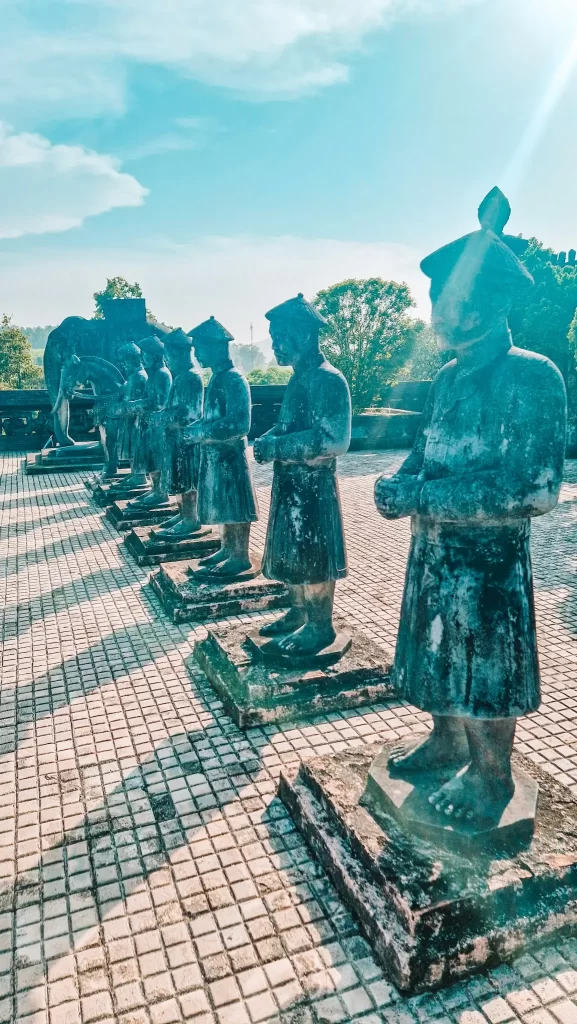
In just 2 days in Hue, you can journey through centuries of imperial power, feel the echoes of war and resilience, and stumble upon unexpected wonders like the Abandoned Waterpark and incense-scented villages. Hue may lack the bustle of Hanoi or the charm of Hoi An—but that’s exactly what makes it special. It’s a place where Vietnam’s past lingers in the air, yet continues to evolve in fascinating ways. If you’re traveling central Vietnam and craving a destination that offers both depth and discovery, Hue is absolutely worth a two-day detour—if not more.

